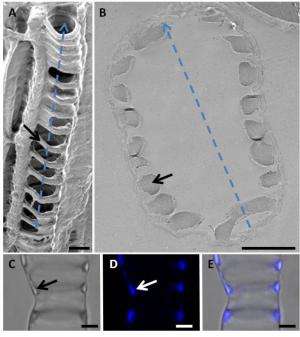Important step in wood formation demonstrated by Bio4Energy scientists

A multi-national research team of researchers in Bio4Energy has been able to demonstrate an important step in wood formation: that a part of plants only forms after the cells that make them up die. According to the research group leader, Edouard Pesquet of Umeå University, the finding is an important step in understanding the way in which wood is constructed and, in turn, can be taken apart in a way suitable for making bio-based products.
What Pesquet's team at the Umeå Plant Science Centre has done, using a combination of techniques, is to trace the formation of lignin in the vessels through which water and nutrients are transported throughout two model plants.
Lignin is one of the two most prevalent polymers in plants, providing stiffness to their stems and leaves. In an article in the Advance Online version of the prestigious The Plant Cell scientific journal, the UPSC researchers show that, in the walls of the so-called xylem vessels, lignin only forms after the host cells "commit suicide".
"The wood cell will kill itself and [together with other deceased cells] become a cylinder—the hydro-mineral sap is conducted in the void inside the wood vessels created by the cell suicide. Reinforcement of the conducting structure will then be made post mortem by enabling the lateral cell wall of the wood to lignify", explained the assistant professor Pesquet from his office at Umeå, Sweden.
The research also showed that surrounding "unlignified" cells aid this process, he added.
Sequence of lignocellulosic biomass deposition defined
"This defines for the first time what is the sequence of lignocellulosic biomass deposition in woody tissue", the French plant biologist said: "Understanding how something assembles is paramount to optimise how to disassemble it".
The two model plants used—Zinnia elegans and Arabidopsis thaliana—are standard study objects for researchers interested in woody feedstock because the pair has similar characteristics to trees. In particular the plants' conducting cells—those which transport the hydro-mineral sap through the xylem vessels—were similar to those in softwood tree species such spruce and pine, Pesquet explained. These are key production species in the boreal belt that encompasses much of northern Sweden's forest wealth.
"This [research] demonstrates a new understanding of lignification of wood cells", he went on, adding that it gave rise to a "need to consider woody biomass in a different way".
'Main recalcitrant factor' - should be removed first
Indeed, biorefinery researchers including biologists such as Pesquet have long been wringing their hands over this "main recalcitrant factor" of wood which is lignin. Much research has gone into trying to separate it from the other chief abundant biopolymer in the tree, cellulose; often by trying to modify the lignin. In pulping, as well as in biofuel making, the quest has traditionally been to extract cellulose which in its pure form renders valuable sugars that can be turned into bioethanol or used as a component in bio-based materials.
However, because of the lignin clinging firmly to it (and to its sister polymer hemicellulose, a group of gummy polysaccharides), this has been easier said than done, and has led an army of chemists and biologist to try to find ways to modify the lignin so as to render the separation process less energy intensive and, by extension, more cost efficient. Indeed, in a much-referenced 2010 article in Bioresource Technology, authors J.Y. Zhu and X.J. Pan, say that the "ultimate goal of biofuel production is net energy output".
But no one wants to get rid of the lignin all together; it makes plants stand up and can be a valuable raw or component material in biorefinery production.
As Pesquet said, "A tree needs it to be able to function. Therefore the death of xylem conducting cells is very important. We mustn't forget that the primary function of wood is to be a vascular system.
"[At the same time] lignin is the main recalcitrant factor. We know now that it is the last thing to be deposited in the wood. If it would be integrated in the matrix with cellulose, it would be much more complicated to remove… Lignin is the last thing added so it should be taken away first".
Pesquet, who was able to catch the death of the xylem cells on video, calling the sequence "beautiful", said he will be presenting his team's "breakthrough" research at a Cell Wall meeting in July, given by the French National Institute for Agricultural Research at Nantes, France.
The Plant Cell article is titled "Non-Cell-Autonomous Postmortem Lignification of Tracheary Elements in Zinnia elegans."
Journal information: Plant Cell , Bioresource Technology
Provided by Bio4Energy




















